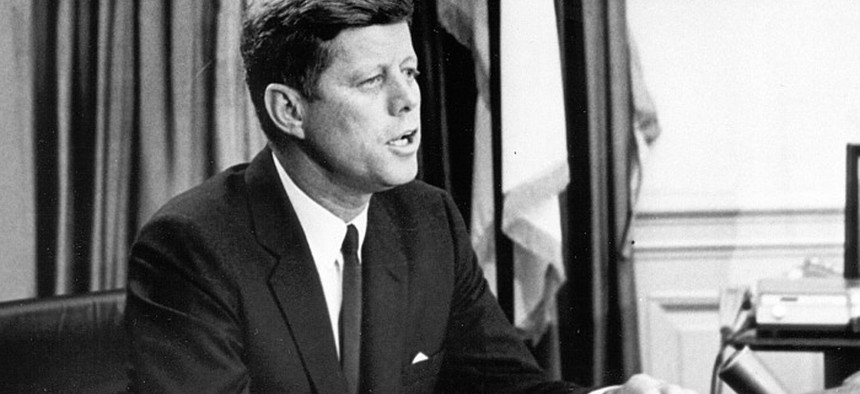Unclassified JFK Assassination Database Still Stored In Top Secret Vault -- for Convenience

National Archives
Until June, a stand-alone PC held the master index of records inside a locked room.
The master database cataloging material related to the assassination of President John F. Kennedy has always been housed in a Top Secret vault, much of the time on a personal computer, according to National Archives and Records Administration officials.
The index -- which does not hold physical artifacts -- was set up in a stand-alone computer in the early 1990s in response to the 1992 JFK Assassination Records Collection Act. The law does not require Fort Knox-like protection. It's just handy for the Archives personnel who use the system to have the JFK database close to other caseloads that include classified records.
"The database has resided in office space that is authorized up to at least the Top Secret level," Archives spokeswoman Laura Diachenko told Nextgov. "It was in this space primarily because the staff who had responsibility for it worked in this space due to their other duties," such as processing Freedom of Information Act requests. "For convenience, the master system needed to be near their work stations. Therefore, it has always resided in classified work space."
While the so-called JFK Assassination Records Collection Database Master System isn't classified, it does contain some content unavailable to the public, she said.
But this is no underground chamber secured by a bank-vault door. It looks more like a cubicle.
"The only visual difference between this office space and any other space in our building is that you would see a combination lock on all of the doors," Diachenko said.
A version of the database available to citizens online is on public-facing servers. Both versions are only finding aids. They contain locations and other descriptive information for physical papers, photographs and analog film. The collection includes, for example, Kennedy’s autopsy report, as well as an audio tape of charges made by political commentator Bill O'Reilly, then a Dallas TV reporter, that alleged assassin Lee Harvey Oswald was employed by the CIA.
The databases do not hold digitized images of the records themselves.
The JFK master database has been shuffled around a bit inside the agency's College Park campus. A 2009 contract solicitation to support the machine and many other Archives systems stated the database was stored on an isolated PC and server inside a "sensitive but not national security classified" vault.
"The PC runs a Clipper application that is used to validate and load records sent by agencies into the JFK server," states the work order obtained by Nextgov. Clipper is a 1990s-era software tool that can be used to enhance and speed up database programs from the 1980s.
The index continued to be stored on a stand-alone PC until June when it was transferred to a new system that tracks the Archive's inventory of classified materials. The "archival declassification redaction and tracking system and unclassified declassification and redaction system," or ADRRES, helps automate the work of sanitizing of materials. It, too, is stored in a Top Secret environment.
One preserved item people won't find indexed is the blood-stained pink Chanel suit first lady Jackie Kennedy wore the day her husband died, Nov. 22, 1963, and refused to clean. She reportedly told aides, “Let them see what they’ve done.”
The Kennedy family did not want to sensationalize that day's relics, so relatives requested it not be seen until more than a century later, in 2103. The New York Times in 2013 reported: "Mrs. Kennedy's clothes are the only items in the assassination collection with this specific restriction. By comparison, scholars and researchers who meet special criteria of the archives may view President Kennedy’s clothing and the rifle used by Lee Harvey Oswald."






